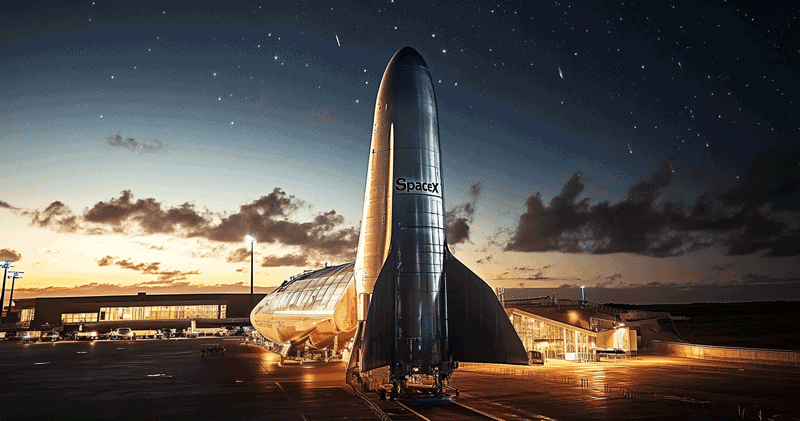
Meet You at the Spaceport
While the supersonic aircraft will transform transoceanic travel, there’s another company aiming for not just interplanetary travel… but also for extremely short hypersonic flights around the globe.


Cruising at Mach 1.7 at 60,000 feet will transform transoceanic travel, allowing us to fly at twice the speed of what we’ve been used to.
Tokyo to Seattle in just four and a half hours. New York to London in just three and a half. Even Los Angeles to the island paradise of Tahiti in just over four hours.
It’s hard to imagine making a day trip to Tokyo from the West Coast for an important meeting, but that’s what supersonic travel will enable.
That’s what we explored in yesterday’s Bleeding Edge – Supersonic Flight Returns – 25 Years Later.
But this is The Bleeding Edge. We’re always thinking about the outer limits of whatever it is we’re learning about.
What if supersonic travel isn’t fast enough?
After all, Tokyo to Seattle is still an entire day of travel. What if we want to get there even faster – for an afternoon meeting and then back in time for supper?
What comes after supersonic travel?
Fortunately, we do have something to look forward to: rocket-fueled, hypersonic travel.
While the supersonic aircraft being built by Boom Supersonic will bring a modern version of the Concorde back to life, SpaceX is building its Starship not just for interplanetary travel, but also for extremely short hypersonic flights around the globe.
Earth-to-Earth (E2E) hypersonic space travel.
Absolutely nuts, I know…
But a near-future milestone, nonetheless.
A Class of Its Own
The Starship and its Super Heavy booster stand 397 feet tall.
And its 33 Raptor engines generate about 16.7 million pounds of thrust. For comparison, NASA’s Space Launch System (SLS) – which costs billions per launch – comes in at 321 feet and only produces 8.8 million pounds of thrust.

The Starship is in a class of its own. It’s the largest and most powerful launch vehicle in history. And it’s the most critical piece of the puzzle to support SpaceX’s, and for that matter, NASA’s ambitions to return to the moon, and eventually manned Mars missions.
SpaceX is democratizing access to space with the Starship. Launch costs per kilogram into low Earth orbit will drop below $100… (How will Starship achieve these ultra-low launch costs? We wrote about this here in Outer Limits – A Historic Day for the New Space Economy.)
This single factor will ignite a vibrant space economy – allowing even small companies to access space – and provide related products and services. (We wrote about this here, in Outer Limits – Made in Space.)
Anyone, Anywhere… in Less Than an Hour
Starship flight test No. 5 is already in the works.
In fact, just three days ago, SpaceX conducted a static fire of Starship’s six Raptor engines. Here’s a short clip of the test. This is a cool video as it’s in slow motion.

Source: SpaceX
Elon Musk has already stated that if flight four goes well (which it did), a Mechazilla tower catch will be possible for test flight five.
And the current expectation is that Starship Flight 5 will happen someday this August.
Below is an animation of what that will look like:

This might look like a novelty, but it’s not.
Reusability and efficiency have been the key to SpaceX’s strategy, which has resulted in decreasing launch costs per kilogram by more than 90%. And with Starship, that magnitude of drop in launch costs will happen again.
The vision is for the booster to be caught and restacked on the launch pad in preparation for testing and relaunch.
The Starship will also land vertically on the launch pad and be lifted by the Mechazilla to be restacked on top of the Super Heavy booster.
Imagine, just imagine, being able to turn around boosters and Starships within a matter of hours to prepare for the next flight.
30 Minutes or Less
Six years ago, SpaceX shared a vision of the future of transportation, whereby anyone could fly to any place on Earth in less than one hour.

The first thing we probably think of when we think about SpaceX is a company launching rockets into space…
But for years, Musk and his team have already been planning for Earth-to-Earth space travel, and to radically reduce flight times to less than an hour.
Most major global routes will be possible in less than 30 minutes of flight time:
- New York to London – 29 min
- Honolulu to Tokyo – 30 min
- London to Hong Kong – 34 min
- New York to Shanghai – 39 min
- Los Angeles to Toronto – 24 min
- London to Dubai – 29 min
- Tokyo to Singapore – 28 min
Imagine being able to fly from a New York area spaceport to Tokyo in just 40 minutes. Not only will businesspeople make day trips, but they could fly out for an important dinner at a fantastic sushi restaurant and return home to sleep in their own beds.
I know that sounds crazy, but it will happen. And much sooner than any of us would think possible.
Business Class
As mentioned earlier, the SpaceX Starship will help accelerate the cost per kilogram to orbit to less than $100. But that’s to Earth’s orbit.
For Earth-to-Earth space travel, the costs will be less… as the Starship doesn’t need to achieve the same altitude.
SpaceX won’t even need to use the Super Heavy booster for the Starship to achieve these routes. It will likely have a modified booster that carries less fuel, an amount appropriate for Earth-to-Earth travel. This will also further reduce costs.
SpaceX has designed the Starship to carry 100 people with all the needed cargo to support life for interplanetary travel and the final destination. But Earth-to-Earth travel won’t need all that cargo space.
Below is a fun graphic comparing a Starship to a Boeing 747.

The Starship has more internal volume (>1,000 m3) for passengers and cargo compared to a Boeing 747 (858 m3). For reference, a Boeing 747-400 can carry 660 passengers.
Musk has said in the past that at scale, SpaceX’s target is launch costs of $2 million per Starship Flight. But let’s increase that to $3 million per flight to be more conservative and assume 500 passengers. That’s $6,000 per passenger. If we mark that number up by 50% for profit for SpaceX or the “spaceline” (instead of an airline), we arrive at $9,000.
Today, a first-class round-trip ticket from New York to Tokyo is $27,000, and business class is $9,500. Therefore a round-trip ticket on a Starship would cost somewhere between a first class and business class fare.
And there would certainly be additional revenues from cargo for each flight. I believe that at scale, the Starship flights will be closer to a business class ticket price.
Which would you rather fly? A 14-hour flight for $9,500 from New York to Tokyo, or $18,000 to cover the same distance in about 40 minutes?
For any skeptics among us who don’t think SpaceX is serious about this, the company is currently building its Starship manufacturing facility in South Texas – its Starfactory – to increase production.
The purpose of the Starfactory is to reach SpaceX’s shorter-term goal which is to build a new Starship rocket every three days, about 100 a year. Long term, SpaceX aspires to build one new Starship every day.
Both supersonic and hypersonic space travel will radically change long-haul routes for commercial aviation. Incumbents like Boeing and Airbus will lose significant market share due to reduced conventional travel for transoceanic flights.
Companies like Boom Supersonic and SpaceX represent the bleeding edge in the aerospace industry.
And given the rapid progress that SpaceX has been making with Starship, I can’t help but think…
Who will be the first to commercial flights?
Will it be Boom’s supersonic flights by 2029? Or the Starship’s hypersonic space travel – spaceport to spaceport?

More stories like this
Read the latest insights from the world of high technology.
-

-

It’s Time to Dream Big Again
JFK’s vision inspired millions who wanted to pursue careers in science and engineering… Trump’s mission to Mars will do...
-

Would a $1 Trillion OpenAI IPO Make Any Sense?
The timing of these discussions by OpenAI to go public next year is suspicious…



